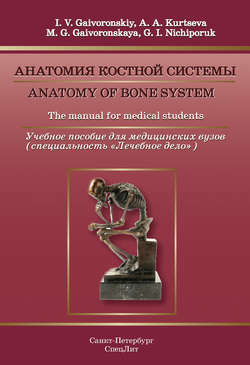Читать книгу Anatomy of bone system. The manual for medical students / Анатомия костной системы. Учебное пособие для медицинских вузов - Г. И. Ничипорук - Страница 6
1. GENERAL ОSTEOLOGY
1.2. Classification of Bones
ОглавлениеIt should be noted that there is no comprehensive classification of bones so far. For this purpose, various criteria are used in most of manuals on anatomy. At the same time, the principles of development and external structure features are often missed. Such feature as the structure of bones has an important clinical value. It determines the level of bone durability and specifications for treatment of injuries. In terms of phylogenesis, taking into consideration the existence of acranial and cranial organisms during the evolution, it is appropriate to divide bones into two groups: 1) bones of trunk and limbs; 2) skull bones. These bones differ from each other not only in their development but also in their structure.
According to the form and structure, four types of trunk and limb bones are distinguished: tubular, flat, volumetric and mixed bones.
Tubular bones have a cavity inside. They may be divided into long (humeral, forearm bones, femoral, leg bones, clavicle) and short (carpals, metatarsals, phalanges) bones.
In long tubular bones, one size prevails over other sizes. The middle part – diaphysis, diaphysis, (or body, corpus) of such bone has a cylindrical or triangular shape and consists of compact tissue, substantia compacta. Within the diaphysis, the medullary cavity is located. The bone ends – epiphyses, epiphyses, – are somewhat thickened. Their surfaces intended for joining with adjacent bones are covered with articular cartilage. On the inside, the epiphysises consist of spongy bone – substantia spongiosa, and on the outside there is a thin layer of compact bone – substantia compacta. Long tubular bones form the proximal and middle parts of the limb skeleton and play the role of leverages actuated by muscles. Short tubular bones form the distal parts of the limb skeleton and also consist of the middle part – the corpus and two ends called basis and caput.
Flat bones mainly consist of homogenous mass of spongy bone covered outside with a thin layer of compact bone. In flat bones, two sizes (width and length) prevail over 1.3. thickness. Such bones form the walls of cavities enclosing important organs, or represent extensive surfaces for attachment of muscles. Here belong the pelvic bones, sternum, scapulae and ribs.
Volumetric bones have the same structure, as the flat bones, i.e. they consist of a thin layer of compact bone outside and spongy bone inside. By shape, they resemble a cube with all dimensions roughly the same. Such bones are the carpal and tarsal bones. These bones are situated on the border between the middle and distal parts of the limbs, where not only high durability, but also high mobility is necessary.
Mixed bones are specific and complicated in shape. In their composition there are structural elements of volumetric and flat bones (vertebrae, sacrum, coccyx). Spongy tissue is contained in the bodies of these bones, and their other parts are mainly formed of compact bone. Such bones possess specific durability at continious loads.
Skull bones are classified by their location, development and structure.
According to location, they are divided into neurocranium bones and viscerocranium bones. According to development: into primary (endesmal), secondary (enchondral) and also mixed bones. The bones of the calvaria and viscerocranium are primary; the bones of the skull base are secondary; the occipital, sphenoidal and temporal bones are mixed; for example, the pyramid of the temporal bone and its mastoid part are secondary, but the squamous and tympanic parts of this bone are primary.
The skull bones have a very complicated external shape, thus it is appropriate to take their structure into consideration. According to the structure, it is possible to distinguish three types of the skull bones: 1) bones having diploё in their composition – diploic bones (parietal, occipital, frontal bones, mandible); 2) bones containing air cavities – pneumatized bones (temporal, sphenoid, ethmoid, frontal bones and maxilla); 3) bones built mainly from compact tissue – compact bones (lacrimal, zygomatic, palatine, nasal bones, inferior nasal concha, vomer, hyoid bone)The diploic substance is like spongy tissue, but its spaces between the osteal trabeculae are significantly smaller in diameter and have rounded shape.
